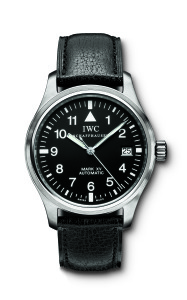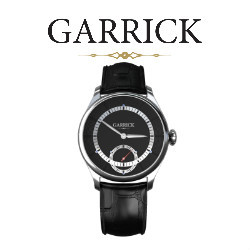You want iconic? Are you after something so utterly immune to the whims of fashion that your great grandson will thank you for buying it in the first place? Amongst military watch aficionados, right up there with 1953 Omegas, the Longines Weems and pre-1970 Panerais, exists a special niche for the ‘Mk’ series timepieces from IWC.
No doubt about it: the definitive model, the one that makes collectors at auctions squabble with hissy-fits worthy of two women fighting at a Manolo Blahnik sale, is the Mk 11, which more than one watchmaker will tell you had the best manual-wind, hours-minutes-seconds-only movement ever made. With hacking seconds, a soft metal inner cover for protection from magnetism, fixed bars for the strap, a beefy case with screw-back and a dial so clear and so truly, well, perfect, the watch has come to represent the definitive style of a post-WWII RAF or NATO wristwatch. One look at it and you know that the watch means business. It’s as above ‘tweaking’ or alteration as a Zippo lighter or a pair of original Ray-Bans.
While a few were offered for sale to civilians, the Mk 11 was primarily military issue and was hard to come buy until the Ministry of Defence dumped them as surplus. I acquired mine (a 1952 model with rare hooked-7 dial) almost 20 years ago, and I recall the dealer telling me how he bought boxes of them for £25 per watch and sent them all to collectors in Asia.
By the time the watch revival hit, with invigorated passion for both vintage and new mechanical watches, the Mk 11 was a bona fide collector’s item and an auction catalogue regular. Today, depending on the watch’s condition, slight variations in the dial and the territory of the auction, you can expect to part with anything from £1000 to £6000 for a Mk 11. And £1500 will get you one that’s knackered at best.
After a long run – 1948/9 to 1983/4 – the Mk 11 was retired. But IWC observed the Mk 11’s value climb in auction, and noted how collectors coveted this relatively obscure watch with a passion rarely shown for contemporary, commercially-available offerings. Following a brief period without a replacement, the Mk XII filled the gap.
(Note to hard-core anoraks: even IWC doesn’t explain why the Mk 11’s model number was shown in Arabic numerals, while all others – e.g. IX, X, XII and XV – are in Roman. Recent IWC literature, however, writes it as XI.)
As for the Mk XII, this watch enjoyed a relatively short lifespan and will prove to be a future collectible, so grab one if you see one. The buzz for it started a couple of years ago. While it doesn’t enjoy the military credibility of the Mk 11, it’s a gem.
In 1999, the Pilot’s Watch Mark XV Classic, to give it its full name, was launched, and it’s just about as desirable a military-style piece as is available today from new. Size-wise, it’s perfect at 9mm thick and 38mm – 2mm larger than the Mk XII. This, it’s large enough to satisfy today’s wearer but small enough to avoid grouping with the more bizarre oversized models hyped as ‘military’ by so many wannabee firms. Inside is the Calibre 37524/30110, a 21-jewel movement that beats at 28,800bph, with a power reserve of 42 hours. Weight with a strap model is a reassuring 73g.
With a few variants available, let’s be clear about just which Mk XV you should consider, sans bracelet and without the aesthetic detail changes imparted by crossing over with the new Spitfire range. For a definitive ‘Mk’ series model, opt for the Reference 3253-01, in stainless steel with black buffalo leather strap.
Its features include automatic winding, centre seconds with hacking (stop) function, an inner case made of antimagnetic soft iron like that which made the Mk 11 so special, date indication, screw-down crown and convex sapphire glass secured against displacement by drops in air pressure. Remember: this is a genuine pilot’s watch.
Personally, I can’t think of a better way to acquire a slice of history, with direct and genuine lineage and without the concerns of maintaining a vintage watch, for a sensible £1950. No, make that a bargain £1950.
Alternatives
Bell & Ross Vintage 123 prices from £1800
No brand has done a better job than relative newcomer Bell & Ross at translating the classic military look into a viable style for the 21st Century. And not just ‘viable’ but desirable – a recent newspaper feature on what’s in and what’s out placed Bell & Ross at the top of the ‘In’ table. Cool? It’s the ultimate choice for those opposed to mere bling. The company’s Vintage 123 (and its sister the Military 123) offers a selection of dial colours, case materials and straps or bracelets, thus creating an entire family of military-styled delights. Automatic, with a 30-jewel movement offering a 40-hour power reserve, small seconds, fluorescent hands and markers – even the ultra-butch strap is so, so right.
Hamilton Khaki prices N/A
If any brand has a legitimate claim to producing military watches, it’s Hamilton. The name has graced many a US army watch’s dial, and even some for the British services. The Khaki line of new, military-styled watches was a stroke of marketing genius (some attribute it to Girard-Perregaux’s Gino Macaluso) that foresaw the retro craze that would take hold in the 1990s. It served the firm well when the blockbuster Pearl Harbor was released, Hamilton having made the watches for the forces in WWII; too bad some putz outfitted the actors with quartz. Anyway, Khaki has evolved into an entire range of models, from time-only to GMTs and chronographs, manual, automatic and quartz. The bad news? No UK distribution. The good news? The most desirable and authentic model – time-only, on a strap and with automatic movement – retails for a silly US $295 stateside. That’s £165 to you and me.
(QP Issue 10, 2004)
© Ken Kessler 2004










